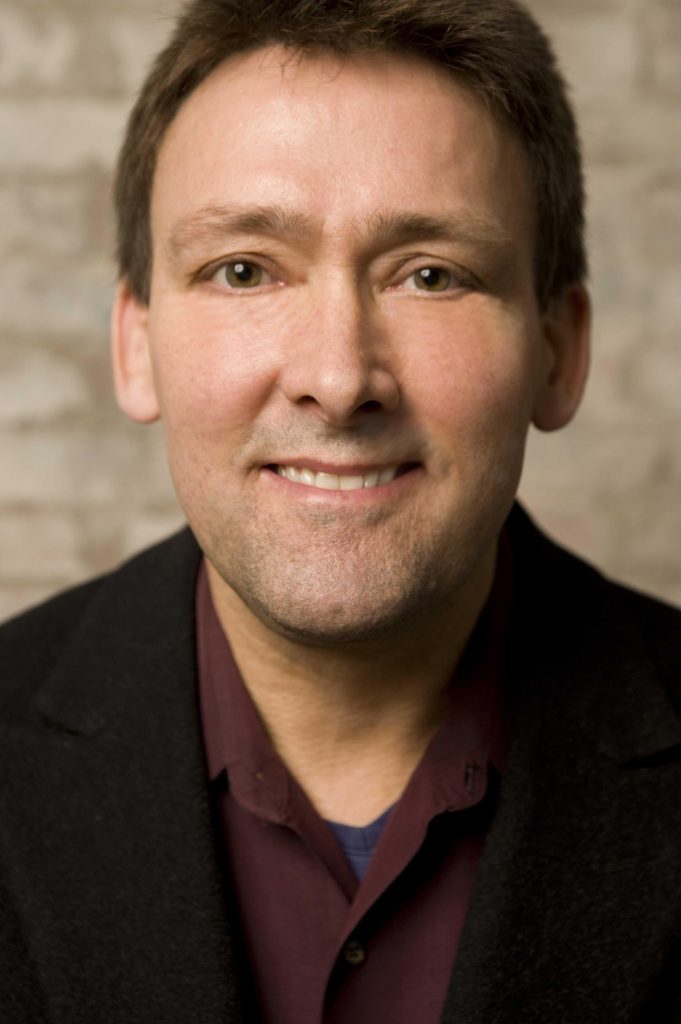Ken Rinaldo is internationally recognized for interactive art installations developing hybrid ecologies with animals, algorithms, plants, and bacterial cultures. His art/science practice is a platform for hacking complex social, biological, and machine symbionts. Inventing and constructing techno interfaces allows illumination and amplifies the underlying beauty and intertwined symbiosis in natural living systems.
Living systems as a model have always been THE tool to critically interrogate technology, itself now enacting evolutionary survival instincts and emergent self-aware software agents.

As biological species have emerged, so too an algorithmic species arises. The availability of knowledge at the fingertips of most has changed the nature of how we imagine and create, and the individual now joins an emergent cognition of web knowledge. Technology is recapitulating phylogeny. We are all composites from multiple species and now technology has become the latest semi-intelligent form to be incorporated into our evolution.
Digital visualization and fabrication technologies are increasingly supplanting the hand of the artist, and the computer has become an ideational amplifier. Epistemology has always been about lenses, and when lenses were analog and made of glass, they changed our world views profoundly. Our lenses are still made of glass, though now silicon and artificial intelligence algorithms are supplanting optical lenses. Instead, data-based algorithmic ways of knowing are becoming predominant. These technologies, in association with biological procedures, such as CRISPR and the AlphaFold Protein Databases, will undoubtedly mean a semi-living constructed species can and will appear.
Living systems as a model have always been THE tool to interrogate technology critically; now, technologies are enacting evolutionary survival instincts and emergent self-aware software agents. As biological species emerge, we now witness an algorithmic species arising. The availability of knowledge at the fingertips of most has changed how we imagine and create, and the individual now joins an emergent cognition of web knowledge fueled by artificial intelligence. Technology is recapitulating phylogeny.
We are all composites from multiple species; technology has become the latest semi-intelligent form to incorporate into our evolution.
Digital visualization and fabrication technologies are increasingly supplanting the hand of the artist, and the computer has become an ideational amplifier. Epistemology has always been about lenses, and when lenses were analog and made of glass, they changed our worldviews profoundly. Our lenses are still made of glass, though silicon and artificial intelligence algorithms are supplanting optical lenses.
Instead, data-based algorithmic ways of knowing are becoming predominant. In association with biological procedures, such as CRISPR and the AlphaFold Protein Databases, these technologies mean a semi-living constructed species can and will appear.
Rinaldo’s works focus on theories of life, symbiogenesis, and transspecies communication and provide models for how technological systems can use structural and process lessons from nature to be more sensitive to all living species. Bio-art, interactive installation, non-violent action, animation, food systems, transspecies artworks, robotic sound sculpture, and rapid prototyping are all areas of expression.
The critical use of technology influences, changes, and further mutates my ideas and our species, while the algorithms increasingly become a selective pressure in a co-evolution with intelligent machines.
Rinaldo’s works have been commissioned by museums, festivals, and galleries internationally, such as; The Art laboratory, Berlin, McDonough Museum of Art, Innovation Media Research and Commercialization Center, US, ALIFE; Mexico, Centro National Arts Mexico, Nuit Blanche, Canada, Museum of Contemporary Art; Chicago, Kiasma Museum; Finland, World Ocean Museum; Russia, Ars Electronica; Austria, National Center for Contemporary Art; Russia, Lille International Arts Festival; France, la Maison d’Ailleurs; Switzerland, Vancouver Olympics; Canada, Platform 21; Holland, Transmediale; Berlin, AV Festival; England, Caldas Museum of Art; Colombia, Arco Arts Festival; Spain, Te Papa Museum; New Zealand, Centro Andaluz de Arte Contemporaneo; Spain, Pan Palazzo Delle Arti; Italy, V2 DEAF; Holland, Siggraph; Los Angeles, Exploratorium; San Francisco, Itau Cultural Museum; Brazil, Biennial for Electronic Art; Australia.
Rinaldo was the recipient of an Award of Distinction in 2004 at Ars Electronica Austria for the Augmented Fish Reality, the first fish-driven robot, and first prize for Vida 3.0 Madrid for his artificial-life robot series Autopoiesis, which also won an honorable mention in Ars Electronica in 2001.
In 2008 Ken Rinaldo and Amy Youngs were awarded a Green Leaf Award from The United Nations Environment Fund for the Farm Fountain, “an invention that could feed the planet.” Rinaldo is the recipient of three Battelle Endowment grants and was a cultural Olympian for the Vancouver Olympics in 2009.
Rinaldo is a member of the Senior Academic Board for Antennae, The Journal of Nature in Visual Culture, and the author of Interactive Electronics for Artists and Inventors. His work has been internationally featured on the radio and TV, including; BBC, ORF, CNN, CNET, CBC & the Discovery Channel.
Select publications include Art and Electronic Media by Edward Shanken, Evolution Haute Couture Art and Science in the Post-Biological Age edited by Dmitry Bulatov, Art and Science by Steve Wilson, Inside Art E Sciencia edited by Leonel Moura, Politics of the Impure V2 Publishing, Digital Art by Christiane Paul, Information Arts by Steve Wilson, Contemporary Italy, NY Arts Magazine, NY Times, Art Press Paris, Tema Celeste Italy and Wired Magazine.
Rinaldo is a contemporary artist and Professor Emeritus teaching neo-conceptual approaches to interactive robotics, bio-art, 2D/3D animation, 3D modeling, rapid prototyping, and broad art practices. He became a Professor of Art & Technology in the Department of Art in the College of Arts & Sciences at The Ohio State University. In 2020 he began teaching a master’s class for the Central Academy of Fine Arts in Beijing, China, in March of 2021.